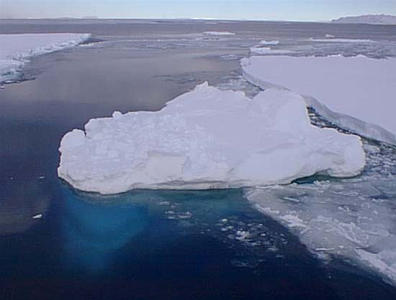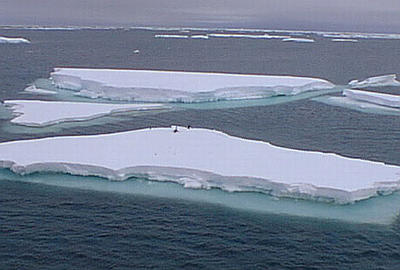26 February, 1999
February 26, 1999
Greetings from the Antarctic! We have been traveling across the Amundsen
Sea all day today. If you are plotting our latitude and longitude each
day, you will definitely notice how far we have gone. We are heading for
the Getz Ice Shelf, and we should arrive there sometime tomorrow. After
that, we'll start back with our multibeam surveys, seismic, deep tow, and
coring. I'm really looking forward to it!
The scenery has been absolutely beautiful down here! Every now and then,
we catch a glimpse of the land or an island. We have driven past tons of
icebergs in the last two days, and they are really awesome! Most of them
are flat on top because they have broken off the ice shelf. Others,
however, are lumpier on the top and seem very out of place. Today, I
didn't see very many penguins . . . but I did see a crabeater seal! What
do you suppose crabeater seals eat for dinner? I bet you'll be surprised
when you find out!
Let's take a look at yesterday's questions: "How many different species of
penguins are there? Do all of them live in Antarctica?" Well, there are
17 or 18 different species of penguins in the world today. Millions of
years ago, there were at least 25 species, but the others have become
extinct. Did you know that 35 million years ago there used to be one type
of penguin that stood five feet tall and weighed over 200 pounds? Wow!
Scientists have found fossils of this huge species of penguin on Seymour
Island off the coast of the Antarctic Peninsula.
Of all the species of penguins today, only seven live in Antarctica. The
Antarctic species include the Emperor, King, Gentoo, Adelie, Chinstrap,
Rockhopper, and Macaroni penguins. Almost all species of penguins live in
the Southern Hemisphere, but they are very widespread. Penguins can be
found in Chile, Argentina, Africa, New Zealand, and Australia. The
northernmost penguin is the Galapagos penguin. They are found in the
Galapagos Islands, which are a part of Ecuador and are found right on the
equator! The only reason they can survive at such a low latitude
(remember, the latitude of the equator is 0) is that the Humboldt Current
brings cool and fertile water to the area. Penguins have several
adaptations to allow them to live in cold climates. Their feathers are
very dense, and they overlap like shingles on a roof. They also have a
layer of down to help protect them from the cold air, winds, and water.
For the penguins that live in the coldest areas, their flippers, feet and
head are shorter to help reduce heat loss.
Five species of the Antarctic penguins are found in the peninsula region or
in the sub-Antarctic islands. Only two species of penguin are truly
Antarctic birds that breed on the continent -- the Emperor and the Adelie
penguins. Emperors are the largest penguins. They can stand over 42
inches tall and can weigh up to 100 pounds. Emperor penguins can travel
along the surface of the water at about five miles an hour and can dive
down to almost 900 feet below the surface. They eat mostly fish (95%) and
squid (3%), as well as some crustaceans such as krill.
Emperor penguins are the only Antarctic birds that breed in the winter.
They arrive on "fast ice" in March or April. (Fast ice is a type of sea
ice that becomes so large and spreads so far that it freezes to the land on
more than one side. This makes it impossible for the ice to move -- in
other words, the ice is held "fast" to the land.) After a prolonged
courtship ritual, a single egg is laid in May or early June. This egg is
incubated on the feet of the male penguin for warmth and protection. The
eggs are also protected from the extreme cold because they are covered by a
fold of the parent's abdominal skin. The male birds huddle together to
help reduce heat loss, and they take turns as to who has to stand on the
outside of the group (where the wind is the strongest). During this time,
the females are out at sea eating and getting fat. Incubation lasts about
66 days, and the mother penguin returns about the time the chick emerges.
Even though it is totally dark, the parents are able to find each other by
cawing (each pair has their own special "song").
Once the females return, the chick is kept warm by the mother, and the
father penguin goes off to sea to fatten up. He is very hungry because he
hasn't eaten in about four months! After the male returns again, the
parents take turns feeding and taking care of the chick. When the chick is
5-6 months old, it becomes independent. By now it is the Antarctic spring
and the chicks are ready to get food on their own. Some emperor penguins
have lived to be 50 years old, but the mortality rate among chicks is high
due to the harsh conditions.
The most common penguin in Antarctica is the Adelie penguin. There may be
as many as two and a half million breeding pairs of Adelies in the
Antarctic. The name Adelie comes from the French explorer Dumont
d'Urville, who named them in honor of his wife. Adelies are much smaller
than Emperor penguins: they stand about 30 inches high and weigh only about
11 pounds. They have no gray or orange markings like some penguins. An
easy way to identify Adelie penguins is to look for their white eye ring.
Adelies have been known to dive down to 175 meters in order to get a meal,
but most of their food is caught near the surface. They eat mostly krill
(68%) and fish (32%). The females lay two eggs in mid-November, which are
incubated for about 34 days. The males incubate the eggs for the first
week or two, while the females return to the sea to eat. For the remaining
weeks of the incubation period, the parents alternate every two to three
days. The chicks are hatched in late December, and the parents continue
alternating their duties of obtaining food for the chicks. By mid-February
the young birds are ready to go to sea. They can live to be twenty years
old, and they like to live in rocky, ice-free areas. The most southerly
colony of Adelie penguins lives not far from McMurdo Station on Ross Island.
Well, that's all for today. I love all of the questions that you are
sending to me. Keep it up!
Kim Giesting
Latitude: 74 degrees 11 minutes South
Longitude: 139 degrees 15 minutes West
Temperature: -5.5 degrees C
Barometer: 983.6 mb
Wind Speed: 8.7 knots
Wind Direction: 103 degrees (from the Southwest)
Sunrise Today: 23:47
Sunset Today: 16:36

These four Adelie penguins were running across the ice.

The color of the submerged sea ice was breathtaking!

The black dots on the sea ice are Emperor penguins.
Contact the TEA in the field at
.
If you cannot connect through your browser, copy the
TEA's e-mail address in the "To:" line of
your favorite e-mail package.
|
